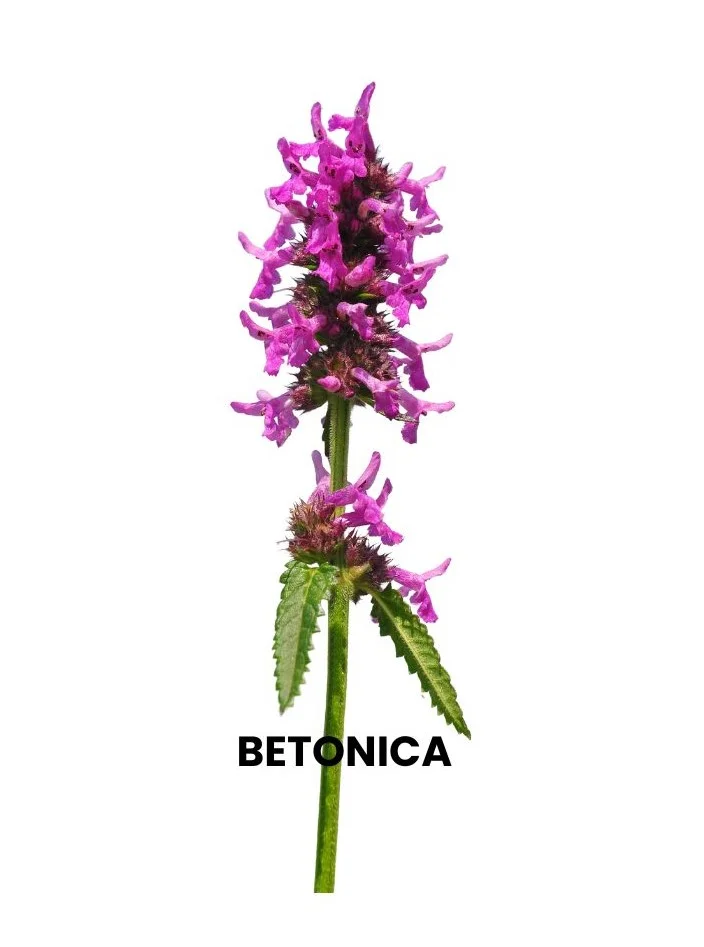Betonica or Stachys Betonica, commonly known as Betony Wood, is a homeopathic remedy derived from the Betonica officinalis plant. It is utilized in homeopathy to address various pains and discomforts experienced in different parts of the body.

SOURCE INFORMATION
Scientific Classification
- Kingdom: Plantae
- Order: Lamiales
- Family: Lamiaceae
- Genus: Betonica
- Species: Betonica officinalis
Origin
- Betony wood, also known simply as betony, is a plant belonging to the genus Stachys within the mint family, Lamiaceae.
- It is native to Europe and Western Asia and is characterized by its erect stems, clusters of purple or pink flowers, and broad, serrated leaves.
- Betony has a long history of use in traditional medicine and herbalism, where it has been valued for its medicinal properties.
- It has been used to treat various ailments, including headaches, gastrointestinal issues, anxiety, and insomnia.
- The dried aerial parts of the plant are often used to prepare herbal teas, tinctures, and extracts for medicinal purposes.
DRUG PATHOGENESIS
- Stachys betonica is known to affect various body systems, particularly the nervous and musculoskeletal systems.
- Its effects include the production of localized pains and discomforts, especially in the head, abdomen, and extremities.
- The symptoms associated with Stachys betonica are often described as sharp or shooting in nature, affecting specific areas of the body and leading to significant functional disturbances.
KEY CHARACTERISTICS
Provokes pains in different body parts
- Betonica induces pain sensations in various areas of the body, suggesting its action on multiple organs and systems.
Stitching pains in the right temple and difficulty concentrating the mind:
- Patients experience sharp, stitching pains specifically localized in the right temple area.
- This discomfort may be accompanied by an inability to focus or concentrate the mind, indicating a cognitive symptom associated with the remedy.
Abdominal pain in specific regions
- Betonica elicits abdominal pain, particularly notable in the hepatic region (related to the liver), transverse colon (part of the large intestine), gall-bladder, right inguinal region (groin area), and spermatic cords (related to the male reproductive system).
- These localized pains suggest an affinity of the remedy for the abdominal organs and structures.
Shooting pains in the back of both wrist joints, leading to wrist drops
- Individuals may experience shooting or lancinating pains originating from the back of both wrist joints.
- These shooting pains can be severe and may result in wrist drops, indicating weakness or paralysis of the wrist muscles.
Pain in the right popliteal space extending down the leg, causing a sensation of paralysis:
- Betonica induces pain in the right popliteal space (the area behind the knee), which radiates down the leg.
- This pain is often accompanied by a feeling of paralysis, suggesting a loss of sensation or motor function in the affected leg.
DOSE
- Betonica is typically administered in the sixth potency.
RELATIONSHIP WITH OTHER DRUGS
Compare with: Remedies that also address localized pain and functional disturbances, such as:
- Rhus Toxicodendron: Known for its effectiveness in musculoskeletal pain, especially when worsened by movement.
- Bryonia: Useful for pains that are aggravated by motion and relieved by rest.
- Arnica Montana: Addresses pain and bruising with a focus on trauma and injury.
Frequently Asked Questions
What conditions is Stachys betonica most effective for?
- It is effective for localized pains in the head, abdomen, and extremities, particularly when these pains are sharp and shooting.
How should Stachys betonica be used?
- It is generally used in homeopathic potencies, with dosages adjusted according to the intensity of symptoms and the patient’s response.
Are there any side effects?
- As with any homeopathic remedy, side effects are rare but can include exacerbation of existing symptoms if not matched properly to the patient’s condition.
Can Stachys betonica be used alongside other treatments?
- Yes, it can be used in conjunction with other homeopathic remedies or conventional treatments, but it is advisable to consult with a healthcare provider for personalized advice.
Meaning of Difficult Words
- Officinalis: Referring to plants that are officially recognized for their medicinal properties and are used in herbal medicine.
- Lamiales: An order of flowering plants, commonly known as the mint or deadnettle order, which includes many herbs and shrubs with aromatic properties.
- Lamiaceae: The mint family, consisting of flowering plants known for their aromatic properties and square stems, including herbs like mint, basil, and sage.
- Musculoskeletal: Relating to the muscles and skeleton, or the combination of the muscular and skeletal systems.
- Hepatic Region: Referring to the area of the body associated with the liver, usually in the upper right quadrant of the abdomen.
- Transverse Colon: The part of the large intestine that runs horizontally across the abdomen.
- Gall-bladder: A small organ located beneath the liver that stores bile produced by the liver.
- Inguinal Region: The area of the body located in the groin, where the thigh meets the abdomen.
- Spermatic Cords: Cord-like structures that contain the vas deferens, blood vessels, nerves, and lymphatic vessels, and are associated with the male reproductive system.
- Lancinating: Describing a sharp, cutting, or stabbing pain.
- Popliteal Space: The hollow at the back of the knee joint.
- Paralysis: Loss of muscle function in part of the body, often resulting in an inability to move or control movement voluntarily.
